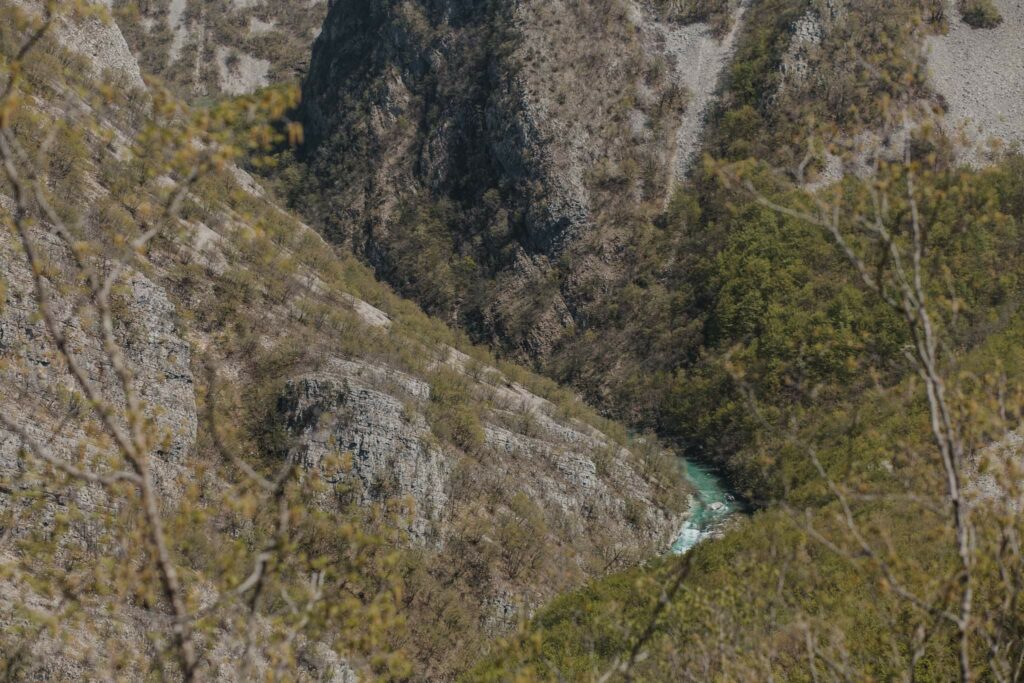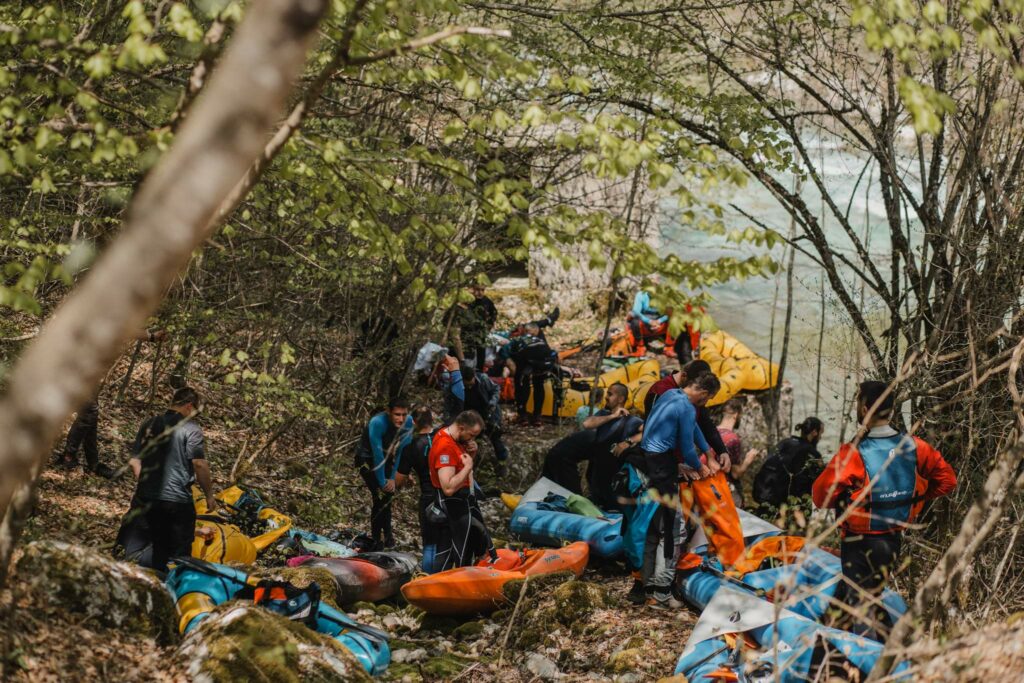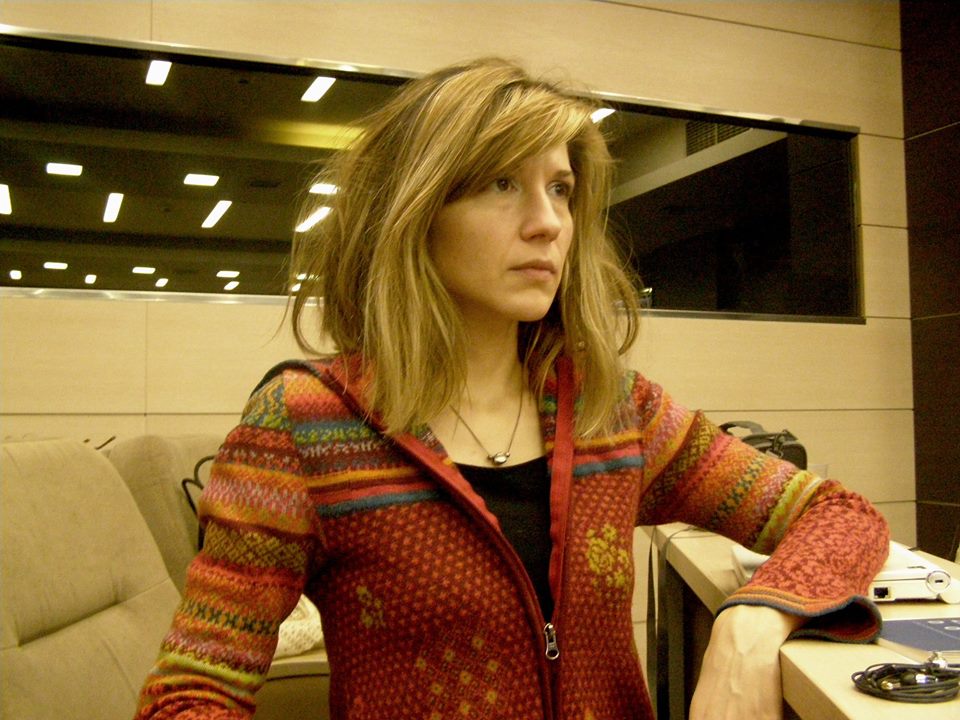
Several Montenegrin associations for nature protection filed a complaint with the Secretariat of the Bern Convention regarding the possible construction of a hydroelectric power plant in one of the last wild canyons in Europe. Montenegro has until mid-September to react. In the meantime, activists and experts insist that the construction of the HPP Komarnica must be prevented. Published originally in Serbian in the regional portal Bilten, this article was translated into English by the author herself in cooperation with ELMO (East European Left Media Organization). All the photographs have been taken by Spasimo Komarnicu/Save Komarnica initiative.
An emerald green river rushes through cascades and rapids, plunges down waterfalls, sharply cutting the karst slopes of the Durmitor mountain in western Montenegro. Komarnica is one of the last wild rivers in Europe; its canyon one of the five most important in Montenegro, and the only one intact. During ice ages its steep slopes were life’s shelter; in warmer epochs, its cradle. Hidden here are a quarter of the 88 habitats of plant and animal species in Europe.
“The symbiosis of such a variety of species in such a small area is breath-taking”, says activist Nina Pantović. “Komarnica was a refuge to relict species, some of which survived only here, and are otherwise extinct”, she adds.
Science has not yet fully grasped the various ecosystems of Komarnica. This is especially true for its caves and its narrowest and most dramatic part, the Nevidio (“The Unseen”) gorge, whose floor is unreached by sun. Man first set foot in Nevidio only in the mid-sixties, and even today it can only be accessed with the help of diving-alpinist equipment and experienced guides.
Komarnica enjoys the status of a natural monument and nature park of Montenegro. It has been nominated to become an Emerald and Natura 2000 site; UNESCO and IUCN (International Union for Conservation of Nature) proposed that it became a part of the Durmitor National Park UNESCO site.

A miscalculated project
Until recently, maps of exploited and devastated areas didn’t include the unpredictable river and the mysterious Nevidio ravine, carved between Vojnik and Durmitor mountains. Unfortunately, this might soon change. In 2012, an outdated project (made in 1972) of a hydropower plant on Komarnica was reactivated by the Government of Montenegro (within the Energy Development Strategy of Montenegro until 2025). Since 2012, state decision makers debated its feasibility several times, with no major conclusions. Steps towards the realization of the project were, however, made recently, and in a strange moment – only days before a political party that had ruled Montenegro for thirty years[1] lost power.
Namely, on August 27, 2020 (three days before the decisive parliamentary elections), the Government of Montenegro granted a concession for the construction of HPP to the Electric Power Company of Montenegro (EPCG). According to available announcements, EPCG would participate in the project with 51% of investments and profits, while the minority partner would be the EP Company of Serbia. Despite hopes that the new administration would take environmental protection much more seriously than the old one, the Ministry of Capital Investments confirmed the concession in early 2022, and an agreement was signed in mid-2022.
Proponents of the project refer to the state’s needs to achieve energy independence and accelerate the transition to renewable energy sources (RES). The current energy crisis works in their favour. Still, activists and independent experts claim that realistic assessments of the state of the domestic energy sector and its development potential, and the irreparable damage which HPP Komarnica would cause are strong enough arguments against its construction.
To begin with, Montenegro is not so far from reaching energy independence and achieving green transition that would make it necessary for to hastily sacrifice one of the last European landscapes of preserved nature in their name. Back in 2018, Montenegro already got almost 40% of its energy from renewables, exceeding the goals of the then National Action Plan, while the share of renewables in total electricity production in 2020 was 53.98%. Activists point out that Montenegro already has the capacity to periodically act as an exporter on the international electricity market.
Of course, they do not claim that green transition should stop there, but they emphasize the importance of alternative directions of development. One of them could be the reconstruction of the electric power network, whose annual losses of 15% double the expected yield of the controversial HPP (7%), and are four times higher than what EPCG will receive from Komarnica in the best case scenario. In addition, they debunk the false idea that the people of Montenegro must sacrifice something (aka the large rivers and their surroundings) in exchange for the protection of small rivers from mini hydropower plants and of the catastrophic pollution stemming from the Pljevlja city Thermal Power Plant. In fact, Montenegro, which already gets close to 80% of its renewable energy from hydrological sources, and only 20% from other renewables, has a huge potential for solar and wind power.
Moreover, investing in wind farms and solar panels, instead of hydropower, would simultaneously help protect nature and diversify renewables. The latter would, in turn, contribute to the stability of the power system, as well as future projects’ economic profitability. For the sake of comparison, the recently built Krnovo and Možure wind farms produce 50% more electricity than Komarnica HPP would, and in sum cost less than the 300 million euros Komarnica would (in the best case scenario). Montenegro also has enviable opportunities for using solar energy – which, in addition, could be harvested in locations that are not so important for the environment or the economy as Komarnica is. Not only rocks and roofs – solar panels could, for example, cover the tailings dump with slag and ash landfill in Pljevlje, as well as the solid waste disposal site of the Podgorica Aluminum Plant and the barren land around it, and finally raise the share of solar energy in renewables from today’s insignificant 0.1%. Activists claim that that would take an investment of about 40 million euros (8-10 times less Komarnica HPP) and the investment would pay off much faster than HPP Komarnica (which, according to most estimates, would not start operating before 2032).
Increasing the share of solar power plants and wind farms in the energy mix of the country is not just an environmentalists’ dream, but also a proclaimed state policy. Namely, at the beginning of March 2022 the Ministry of Capital Investments of Montenegro announced that it had launched a special program for this purpose and agreed on financial support from the European Bank for Reconstruction and Development (EBRD). However, even though, among other things, they will invest in the Gvozd wind farm and the solar power plant on Lake Slano in Nikšić, Komarnica HPP still appears on the list of priority infrastructure projects published at the beginning of 2022, as the largest in the field of energy.
Activists claim that the profitability of the Komarnica HPP is questionable even without the comparison with alternative projects. They point out that the investment was estimated at 300 million back in 2020, before the prices of construction materials and equipment skyrocketed. They also point out that the estimates of its yields were made without taking into account climate change, due to which the existing HPP Perućica and HPP Piva produced significantly less electricity last year and the year before.
“We are witnessing one of the driest years in the last 50 years and precipitation is no longer reliable. What we are calling for is to use biodiversity-poor areas such as rocky areas for the construction of solar towers, which can produce electricity 24 hours a day, and at the same time have less impact on the environment than projects such as large and small hydroelectric plants”, says Pantović, a member of the Save Komarnica initiative.
The authorities also chose to ignore the fact that there is a tectonic fault in the canyon that calls into question the feasibility of forming a 171m high concrete dam and a 17km-long storage lake, as well as concerns that the use of the storage would threaten the stability of the terrain (which made potential investors give up on the project in 2013). The emptying of a similar lake on the river Piva has been linked to an increase in the incidence of earthquakes. From the point of view of the local population, in addition to the loss of tourist potential, the construction of the dam and reservoir lake carry with them serious security risks. At the same time, the announcement that the minority partner in the construction and exploitation will probably be the Electric Power Company of Montenegro make people worry that Serbia is once again interfering in vital issues in Montenegro. Thus, the construction of HPP Komarnica could also represent a risk for the fragile terrain of political relations in the region.
Distrust in state authorities
The pro-government media, meanwhile, throw around figures about the economic improvement the Komarnica HPP would mean to the local community, announcing, for example, that the economically poor Municipality of Šavnik would receive 2.5 million euros per year. The protectors of Komarnica have a difficult task to deny such claims one by one. In the case of these particular allegations, they point out that the concession agreement stated that 1% of the total revenue generated by Komarnica HPP, which EPCG estimated at 46 million euros per year (in other words: 460.000€), would be divided between the municipalities of Šavnik and Plužine. Activists also point to the fact that the profit the Municipality of Plužine makes from a bigger HPP, Piva, is around 900,000 euros annually – much, much less than 2.5€.
However, it is not possible to precisely comment on the potential economic interest of the local population, as well as the interest of Montenegro, in the Komarnica HPP project, because the details of the project are not available to the public. The Montenegrin Ecologists Society (CDE) protested because the Electric Power Company of Montenegro (EPCG) failed to provide them with either the contract EPCG signed with EPS (in 1991) or the conceptual design for the project. In order to communicate all the above listed problems more loudly to the public and the authorities, environmental activists and experts founded the civil initiative Spasimo Komarnicu (Save Komarnica) in early 2022 and held an alternative public forum at the end of March, after the management of EPCG refused requests made by activists to organize it formally. Save Komarnica also draws attention to the fact that this project would have been stopped earlier if the new authorities had kept their pre-election promises about respecting the constitutional provisions of Montenegro as an ecological state, introducing stricter control over the work of the state administration and greater involvement of the public in decision-making processes. The technical government lead by the then prime minister Zdravko Krivokapić would not have been able to confirm the concession if it had kept its word and passed the Law on Government.
As in all similar situations, citizens were forced to draw attention to their interests and those of the environment by holding public gatherings. A four-day gathering of locals, experts and activists was held from April 30 to May 3 in the village Brezni near Komarnica. Since nothing upsets politicians as much as a media scandal, the opponents of HPP Komarnica were soon visited by Prime Minister Dritan Abazović and the then Minister of Ecology Ana Novaković Đurović. Abazović’s civil movement URA, a minority player in both ruling coalitions since the fall of the DPS, is, let’s recall, the only formally green-oriented party in Montenegro. In recent years, URA supported the moratorium on the construction of mini hydro plants and initiatives against the construction of the military training ground on Sinjajevina, but also lost some of the trust of green-oriented voters due to insufficient determination in stopping environmentally harmful projects. That is why Abazović’s promise to the activists that the then Government of Montenegro would not take any steps that could be harmful to the environment at Komarnica was met with reserve.

At the same time, activists have no trust in the claims of representatives of EPCG that submerging a part of the canyon would not be harmful to nature. They draw attention to the fact that in the Elaboration of the environmental impact assessment of the Komarnica hydroelectric power plant, commissioned by EPCG, it is clearly stated: “The construction of the hydropower system at Komarnica will have a significant impact on the degradation of the habitat, the reduction of the value of biological diversity and the ecosystem and the entire biome.” This study shows that the HPP construction plan “ignores the recommendations and environmental regulations of the European Union, such as, among others, the Habitats Directive and the Birds Directive,” the Center for Bird Protection and Research pointed out.
Persisting in their struggle to preventing the harmful construction, the Montenegrin Ecologists Society (CDE), the NGO Young Environmentalists from Nikšić and the KOD Organization filed a complaint with the Secretariat of the Bern Convention regarding the decision of the Government of Montenegro to approve the concession. According to their allegations, Montenegro has violated articles 3 and 4 of the convention, which legally obliges the signatories to improve and preserve wild flora and fauna, and Recommendation no. 157 (2011) of the Standing Committee concerning the conservation of wild animals and natural habitats. The complaint was accepted as valid, which temporarily stopped the project.
Representatives of the government spent the summer giving contradictory statements. In late August Montenegro’s government collapsed after its parliament voted in favour of a no-confidence motion. Citizens are now waiting for the new government, third since August 2020, to be formed, and for it to respond to their and the requests by the Bern Convention. As Pantović explains, the struggle continues:
“The ‘Save Komarnica’ initiative is patiently waiting on the response of the Bern Convention Office on our complaint about the violation of the agreement of the same name. In addition, we are putting pressure on the Government of Montenegro to create a new, sustainable Energy Development Strategy, which will include more energy facilities from renewable sources that do not include hydropower facilities.”
[1] The Democratic Party of Socialists (DPS), a political party lead by Milo Đukanović, who has also been the central figure of political power in Montenegro, either as president or prime minister, since the late eighties. Đukanović is still the president of Montenegro


